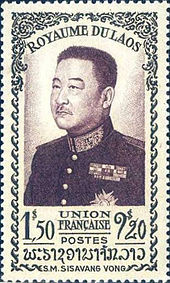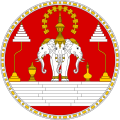Kingdom of Laos
| ພຣະ ຣາ ຊ ອາ ນາ ຈັກ ລາວ | |||||
|
Phra Ratxa A-na-chak Lao |
|||||
| Kingdom of Laos | |||||
| 1949-1975 | |||||
|
|||||
| Official language | Laotian | ||||
| Capital | Vientiane and Luang Prabang (royal city) | ||||
| Form of government | Constitutional monarchy | ||||
| Head of state | King Sisavang Vong (1949–1959) Savang Vatthana (1959–1975) |
||||
| Head of government | Prime Minister Suvanna Phūmā (1951–1954, 1956–1958, 1960 and 1962–1975) |
||||
| surface | 236,800 km² | ||||
| population | 3,100,000 | ||||
| Population density | 13.1 inhabitants per km² | ||||
| currency | Lao kip | ||||
| founding | 1949 | ||||
| independence | 1953 | ||||
| resolution | 1975 | ||||
| National anthem | Pheng Xat Lao | ||||
| Time zone | UTC +7 | ||||
| License Plate | LAO | ||||
| Telephone code | +856 | ||||
| Location of the Kingdom of Laos in Southeast Asia | |||||
The Kingdom of Laos ( Lao : ພຣະ ຣາ ຊ ອາ ນາ ຈັກ ລາວ , Phra Ratxa A-na-chak Lao) existed from 1949 to 1975 and became independent from France on November 9, 1953 . The kingdom was the first independent Laotian state in modern times and was ruled by the kings Sisavang Vong (1949–1959) and Savang Vatthana (1959–1975). It was replaced on July 19, 1949 within French Indochina in the Union française autonomously and as a result of the communist takeover of August 23, 1975 in the Vietnam War on December 2, 1975 by the People's Democratic Republic of Laos .
history

To enable a united kingdom, Boun Oum of the Kingdom of Champasak renounced his claim to the throne in August 1946 in favor of the king of Luang Prabang.
As a result of the Franco-Lao treaty of 1953, the Lao royal government took over the country. In the treaty, a constitutional monarchy was established under King Sisavang Vong and Prime Minister Suvanna Phūmā with the capital Vientiane and the royal city Luang Prabang . Since only a part of the Laotian independence fighters were satisfied with the treaty, the independence movement Lao Issara ("Free / Independent Lao") split off. In the years that followed, France's influence declined and the United States gained influence.
On 21 July 1954 France recognized at the Geneva Conference final independence of Laos and renounced all claims in Indochina , which in 1946 erupted Indochina War ended and Indochina in the independent states of Laos, Cambodia , North Vietnam and South Vietnam was divided. Civil war broke out in Laos as early as 1954, which lasted until 1975 and led to the abolition of the monarchy. In 1958, Prime Minister Suvanna Phūmā formed the first provisional unity government, which only existed for five months.
In 1960, after several rebellions, the power struggle broke out between the government and the Pathet Lao . In 1962, Prince Souvanna Phouma failed to found a second provisional unity government, which intensified the conflict.
Although Laos remained neutral in the Vietnam War , the CIA waged a war against the Pathet Lao from Long Cheng in the 1960s and 1970s with a secret Hmong army that it had raised itself .
Before and during the Vietnam War, the United States supported the government and the Hmong against the Pathet Lao , Việt Minh, and the communist movement of North Vietnam . In addition, supported France , Australia , Myanmar , Thailand and Japan the government. Since the Ho Chi Minh Trail ran mostly through Laos, the United States bombed large parts of the country.
In February 1973, at the Paris Peace Conference, a truce was signed between North Vietnam and the United States, and in April 1974 Souvanna Phouma's attempt to form a third provisional unity government failed. At that time, the Pathet Lao already controlled large parts of the country and in April 1975 they took the capital. In December 1975, Prince Vong Savang handed over the abdication of King Savang Vatthana to the Pathet Lao. The Lao People's Democratic Republic was then founded with Prince Souphanouvong as President and Kaysone Phomvihane as Prime Minister and General Secretary of the Lao People's Revolutionary Party .
When the United States withdrew more and more from Laos towards the end of the Vietnam War, the Hmong conflict began , some of which is still ongoing on the border with Thailand.
After the king was disempowered and the communists came to power, the royal family went into exile in Washington, DC, and is striving to reestablish the monarchy from there.
Individual evidence
- ↑ Laos - Glossary. Library of Congress, accessed July 1, 2010 .
- ↑ The largest military operation by the CIA. The daily newspaper , accessed on July 1, 2010 .
- ↑ Indochina - United States Emergency Aid to Laos and Thailand in the Face of Viet Minh Aggression: Statement by the Secretary of State at a News Conference, May 9, 1953. In: Yale Law School Avalon Project. Lillian Goldman Law Library, 1996, accessed July 1, 2010 .
- ↑ War scraps in Laos - garden fences made from aircraft bombs. Spiegel Online , accessed July 1, 2010 .
literature
- Oliver Tappe: History, nation building and legitimation politics in Laos . 2008, ISBN 3-8258-1610-9 ( excerpts ).
- Michael Schultze: The History of Laos . 1998, ISBN 3-88910-136-4 .
- Martin Stuart-Fox : A History of Laos . Cambridge University Press, 1997.
- Kenneth Conboy: Was in Laos 1954-1975 . Squadron / Signal publications, 1994.
Web links
- Brian McCartan: AN ATol INVESTIGATION The wrong way to end a secret war. Asia Times Online , accessed July 1, 2010 .



